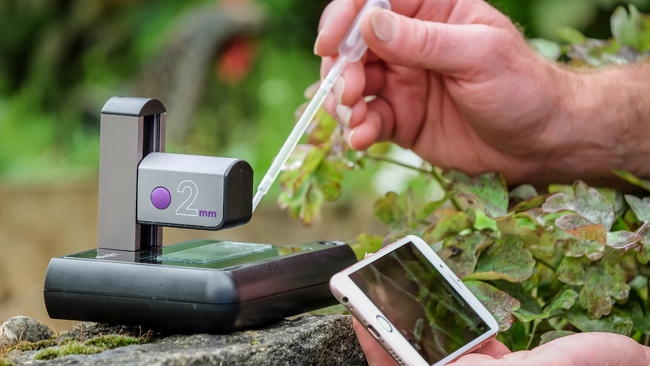
Water sample is deposited under a special microscope that is synced to the user’s cellphone to take pictures. The photos are uploaded to the BloomOptix server for diatom identification and cell count analysis. Credit: BloomOptix
Contact:
Antoinette Clemetson, NYSG Marine Fisheries Specialist, E: aoc5@cornell.edu, P: (631) 824-4407
AI technology is used to obtain faster testing results when assessing harmful algal bloom events
Stony Brook, NY, March 25, 2024 - Stringent field monitoring in coastal waters enables managers to make appropriate decisions to minimize risks of exposure to toxic marine algae by the public who consume fishery resources and utilize bathing beaches. Presently, managers lack the capability to conduct real time assessment of harmful algae in impacted waters to inform decisions about area closures.
New York Sea Grant organized an outreach effort to increase awareness about a new tool developed by BloomOptix and the State University of New York College of Environmental Science and Forestry (ESF) to allow faster testing results to identify harmful algae and estimate cell count in real time.
New York Sea Grant organized a webinar demonstration of a new tool that uses a portable digital microscope that can be linked to a cell phone to send images of water samples to a web- based AI system that carries out the classification (see additional info at website: https://bloomoptix.com/). This technology is intended to be used by citizen science groups and water managers looking to make a rapid determination of the presence of harmful algae. This is the first introduction of the tool for utilization in marine waters, building upon its successful use in freshwater systems in upstate New York, Wisconsin, and Oklahoma. As a result of this outreach, three agencies indicated their desire to collaborate with the researchers to build the AI reference library during the 2024 HAB season. A training workshop and equipment will be provided in Spring 2024.
New York Sea Grant is collaborating with researchers to educate managers about new tools to help keep stakeholders safe from toxic algae and improve monitoring response.
Project Funders:
• BloomOptix
• SUNY College of Environmental Science and Forestry
More Info: New York Sea Grant
New York Sea Grant (NYSG), a cooperative program of Cornell University
and the State University of New York (SUNY), is one of 34 university-based
programs under the National Oceanic and Atmospheric Administration’s
National Sea Grant College Program.
Since 1971, NYSG has represented a statewide network of integrated
research, education and extension services promoting coastal community
economic vitality, environmental sustainability and citizen awareness
and understanding about the State’s marine and Great Lakes resources.
Through NYSG’s efforts, the combined talents of university scientists
and extension specialists help develop and transfer science-based
information to many coastal user groups—businesses and industries,
federal, state and local government decision-makers and agency managers,
educators, the media and the interested public.
The program maintains Great Lakes offices at Cornell University, SUNY
Buffalo, Rochester Institute of Technology, SUNY Oswego, the Wayne County Cooperative Extension office
in Newark, and in Watertown. In the State's marine waters, NYSG has offices at Stony Brook
University and with Cornell Cooperative Extension of Nassau County on Long Island, in Queens, at Brooklyn College, with Cornell Cooperative
Extension in NYC, in Bronx, with Cornell Cooperative Extension of Ulster County in Kingston, and with Cornell Cooperative Extension of Westchester County in Elmsford.
For updates on Sea Grant activities: www.nyseagrant.org has Facebook, Twitter/X, Instagram, and YouTube links. NYSG offers a free e-list sign up via www.nyseagrant.org/nycoastlines for its flagship publication, NY Coastlines/Currents, which is published quarterly.